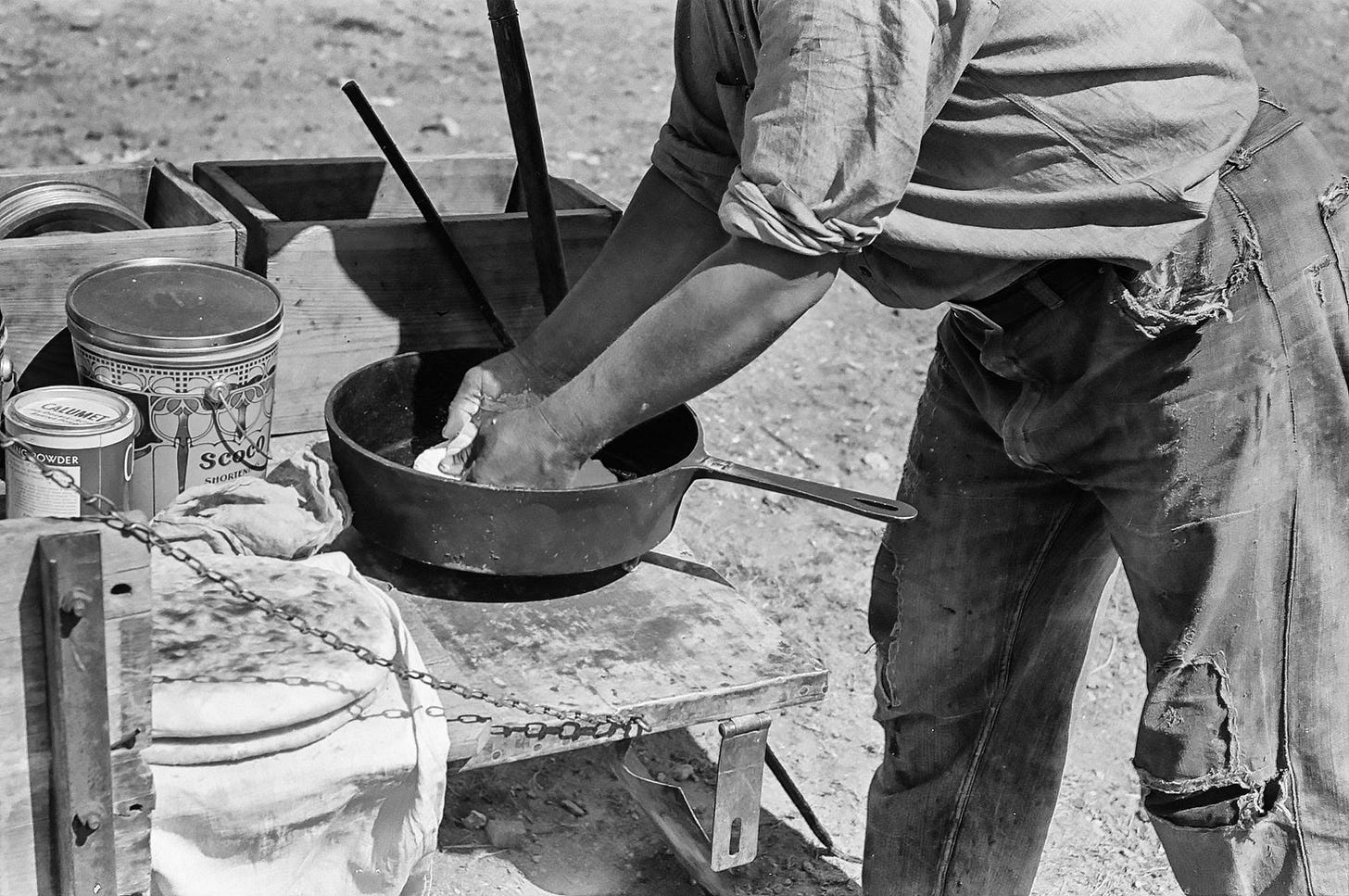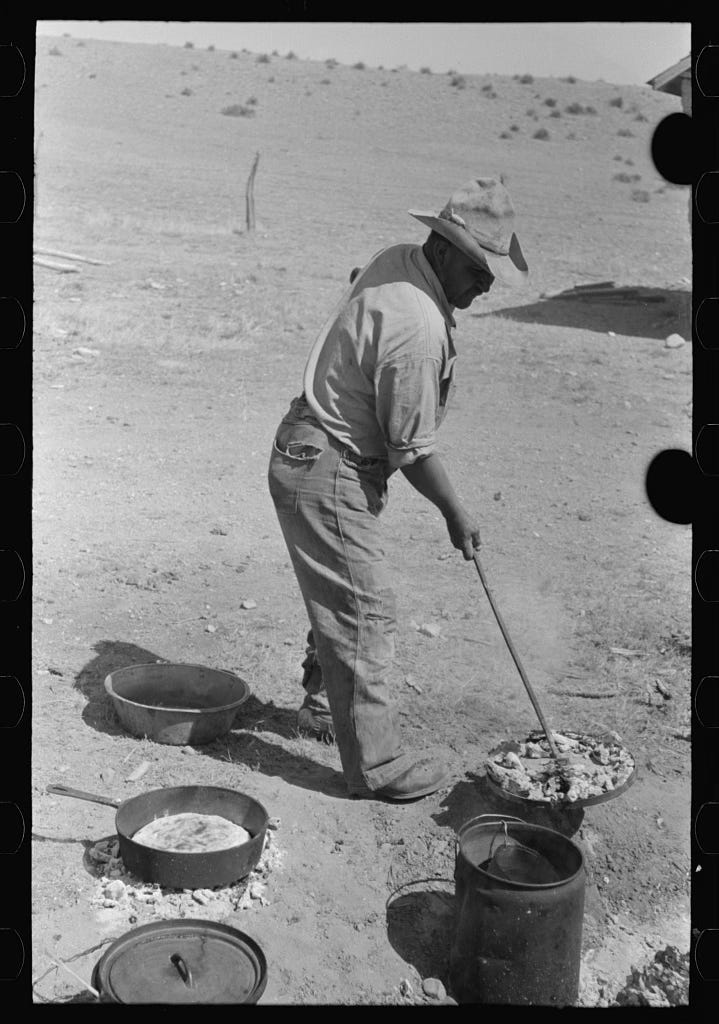Chuckwagon Grub: Pan de Campo

The colorful history of the Lone Star State is inextricably associated with the romance of cowboy culture, and among the many legacies of this proud heritage is the delicious flat bread known as pan de campo, or cowboy bread.
House Concurrent Resolution, no. 98, June 18, 2005
In late 2022 and early 2023 I wrote a series of articles on chuckwagons and cowboy cooks, including early trail recipes, how to comport yourself around a chuckwagon, and the colorful names cowboys gave to trail cooks. In the article on cowboy recipes I failed to mention a number of other staple meals prepared on the trail and thought I ought to supplement it with a new series on chuckwagon grub for those who might want to turn their fork in trying one of these meals. We’ll start with an iconic bread: pan de campo.
The cowboy as we’ve come to know him in history and myth finds his roots in the borderlands watered by the Rio Grande. No matter his ethnicity, he’s a son of Mexican vaqueros. And in many ways, so is his diet, whether it be beans, chili, or a special kind of flat bread: pan de campo or “camp bread.”
Like tortillas and other flatbreads baked in Mexico and South Texas, pan de campo, also known as “cowboy bread,” is a hardy staple filling the hungry bellies of hardworking men. Because of its simplicity and versatility it became a favorite of trail cooks, who had to make do with what they could carry in their chuckboxes, supplementing with whatever they could procure from nearby homesteads or towns or gathered along the trail—herbs, fruits, berries, or nuts. This generally meant his staples had to be durable, simple, and portable. As I explained in “Chuckwagons and Biscuit Shooters” most cow cooks carried a jar of sourdough starter, flour, baking powder, salt, sugar, lard, bacon, and beans. He might also pack his pantry with dried fruit, canned goods, and condensed milk.

In comparison to what a trail cook carried in his chuckwagon, the individual cowman on the trail, with nothing more than the horse he rode and a packhorse he pulled, carried very little in the way of foodstuffs and cooking equipment. Every man carried a coffeepot, tin cup, skillet, and eating utensils. He might store a handful of beef jerky in his saddlebags and pack a sack of coffee and a bit of sugar. Toteing a jar of sourdough starter was out of the question, however. So, if he wanted bread of some sort he packed a small sack of flour, baking powder, salt, and lard. He always had a canteen of water if a stream wasn’t at hand.
With these few ingredients, a cow cook and a cowboy could easily make pan de campo—and so can you. On the range, cooks used Dutch ovens, cooked over coals. Modern cowpunchers can cook in the range (your oven) in a greased twelve-inch cast-iron skillet. Here’s a simple recipe.*
Pan de Campo
2 cups all-purpose flour
2 teaspoons baking powder
1/2 teaspoon sugar
6 tablespoons lard (or shortening) slightly chilled
3/4 cup whole milk
Preheat oven to 450°. Stir together the dry ingredients, then work in the lard (shortening) with a pastry cutter or fork until the mixture is crumbly. (Don’t use your finger to blend together because the heat from your hands might melt the lard/shortening, causing the dough to lose air pockets, resulting in a denser bread.)
Add milk a little at a time, until you can form a not-too-sticky ball of dough—the consistency of Play-dough. Turn it out on a floured surface and knead gently for about one (1) minute. Flatten the ball of dough and roll out round about 1/2 inch thick. Prick the top all over with a fork.
Melt a little lard (shortening) in a 12-inch cast-iron skillet (enough to coat the bottom). Place the round dough in the skillet and put in the oven, uncovered. Bake for about six (6) minutes, then flip the bread and bake another six (6) minutes. The bread is ready when you can prick it with a toothpick and the toothpick comes out clean.
Bread should look like cornbread: flat and golden brown. Remove from oven and let cool before cutting. The outside should be crisp with a soft, chewy inside. Like cornbread, cut into wedges and serve with slathered butter or as a sop for stew or chili.
* Though I’ve seen this recipe elsewhere, I’ve reproduced the one from Courtney Bond, Texas Monthly (November 2016).
Y’allogy is an 1836 percent pureb
red, open-range guide to the people, places, and past of the great Lone Star. We speak Texan here. Y’alloy is created by a living, breathing Texan—for Texans and lovers of Texas—and is free of charge. I’d be grateful, however, if you’d consider riding for the brand as a paid subscriber and/or purchasing my novel.
Be brave. Live free.


